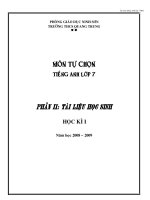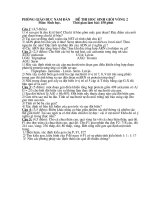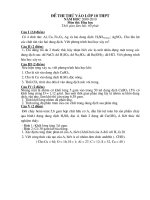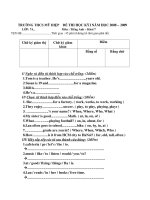chapt 09 lecture 2
Bạn đang xem bản rút gọn của tài liệu. Xem và tải ngay bản đầy đủ của tài liệu tại đây (3.03 MB, 55 trang )
Chapte r 9
Water and
Minerals
Water
50%-70%
Muscle
of body weight
contains 73% water
– Fat contains ~20%
Intracellular
fluid
– Fluid within the cells
Extracellular
fluid
– Fluid outside the cells
Fluid Balance
Water shifts freely in and out of cells
Controlled by electrolyte concentration
– Have electrical charges . . .Na, K, Cl, P, Mg, Ca
Osmosis (where an Ion goes, H2O flows)
Intracellular water volume
– Depends on intracellular potassium and phosphate
concentrations
Extracellular water volume
– Depends on extracellular sodium and potassium
concentrations
where an Ion goes, H2O flows: fig 9:2
Na
Na
Na
Na
Na
H2O
Na
Na
Na
Functions of Water
Body temperature regulation
– Water absorbs excess heat
– Body secretes fluid via perspiration
– Skin is cooled as perspiration evaporates
– Humidity (bad) & fans (good) ~ evaporation
Removal of body waste via urine
– Urea excretion (Nitrogen from Protein breakdown
– Sodium excretion
– Avoid concentrated urine (brownish)
Amniotic fluid, joint lubricants, saliva, bile
Are You Drinking Enough?
Fluid recommendation: 9 cups for women and
13 cups for men as a starting point
Min. 2-4 water bottles/day
Thirst Mechanism
Not reliable
Concerns for infants, older adults, athletes
Athletes
– Weigh before and after training session
– Consume 3 cups for every pound lost
Illness (vomiting, diarrhea, fever)
– Get additional water
Ignoring the Thirst Signal
Shortage of water increases fluid
conservation
Antidiuretic hormone (vassopressin)
– Released by the pituitary gland
– Forces kidneys to conserve water (reduce
urine flow)
Aldosterone
– Responds to drop in blood pressure
– Signals the kidney to retain sodium (water)
Hydration
Loss of 1%-2% of body weight in fluid
– Thirst signal
Loss of 2% or more of body weight causes
muscle weakness (stay hydrated –training)
– Lose significant strength and endurance
Loss of 10%-12%
– Heat intolerance
Loss of 20%
– Coma and death
Too Much Water
Overburden
Low
the kidneys
blood electrolyte concentrations
Blurred
vision
-Confirming your knowledge Q
What is the Minimal amt. of H2O from fluids
that Humans require/day to replace daily loss?
What is the recommended amt. of water from
fluids that women and men require/day?
Minerals
Various
functions in the body
Major Minerals
– Require >100 mg /day
– Calcium, phosphorus etc.
Trace
Minerals
– Require < 100 mg/day
– Iron, zinc, selenium etc.
For 5 pts & Make it a Half day???
What do you say?
Go see “Food Inc.” the movie
Nickelodean theatre (downtown SC)
3, 5, 7 & 9PM showtimes. . .
– Answer 3 short questions (class website)
– Turn in with TICKET STUB Next Wednesday
– See Trailer
/>
-Confirming your knowledgeWhat are the 7 Major minerals
required in the body?
1
2
3
4
5
6
7
-Confirming your knowledgeWhat are the 7 Trace minerals
required in the body?
1
2
3
4
5
6
7
Most mineral requirements
are obtained without defic. in
N. American diets
Bioavailability of Minerals
Fe
Mg
Cu
Zn
~Degree of absorption
Affected by binders in plants (oxalic acid, phytic acid)
– Fibrous foods
Animal products are better absorbed
Plants depend on mineral content of soil
Refinement lowers mineral content (i.e. milling Grains)
Mineral-mineral competition (e.g. >>Zinc vs
Vitamins-mineral interactions:
– Iron w/ (Vit C), Calcium w/ (Vit. D) most efficient
Mineral Toxicity
Trace
minerals are more toxic
– e.g. Fe, stomach irritation
Result
of supplementation
– Presence of contaminants (esp. Lead (Pb))
– Look for the United States Pharmacopeia
(USP)-approved brands (most reliable)
Minerals of Concern in the Diet
Sodium (Na) ~ consume too much >2400mg/day
Hypertension (HTN) and CVD
Calcium (Ca) ~ not enough, esp. Women osteoporosis
Iron (Fe) ~ not enough, esp. Women
– Men require
8 mg/day
– Women require 18 mg/ day
Menstral flow
Supplements hard to digest ?
All other Major and Trace minerals (ok) ~ balanced diet
– Avoid supplementing to try and balance or optimize
Leads to mineral competition deficiencies
Sodium
Table salt (NaCl): 40% sodium, 60% chloride
95% of ingested sodium is absorbed
Positive ion in extracellular fluid
Aldosterone regulates sodium balance
Key for retaining body water
Excretion regulated by the kidneys
Muscle contraction
Conduction of nerve impulses
Food Sources of Sodium
Most sodium is added by food
manufacturers and restaurants
Milk and dairy products
Processed foods
Sodium content listed on the labels
Sodium Needs
Adequate Intake is 1500 mg for adults
Body only needs 200 mg to function
Daily Value is 2400 mg/day
Upper Level is 2300 mg
Typical
intake is 4700 mg/day (US)
Sodium-sensitive individuals should restrict
intake (African American)









